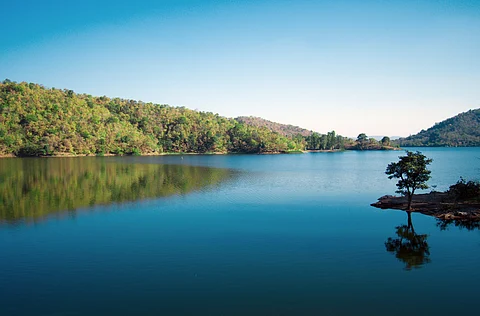
- Destinations
- Experiences
- Stay
- What's new
- Celebrating People
- Responsible Tourism
- CampaignsCampaigns
- Subscribe
- Buy Now

On the border between Gujarat and Rajasthan lies a little-known green space that nature lovers would do well to visit on their next holiday: the Polo Forest. This 400 sq km area of dry mixed deciduous forest is rooted with more than 450 species of medicinal plants and is the habitat of around 275 species of birds, 30 types of mammals and 32 kinds of reptiles.
Until recently, the Polo Forest of Gujarat was not well-known and saw few visitors. But a visit to this stunning landscape reveals Adivasi settlements, ancient temples and legends that tap into the heady days of Rajasthani kings.
Believed to have been established in the 10th century by the Parihar kings of Idar, the ancient city of Polo was built around the Harnav River, a body of water mentioned in the “Puranas.” Five centuries later, it was conquered by the Rathod Rajputs of Marwar, who bestowed the name pol (gate) on the city to signify its status as a gateway between Gujarat and Rajasthan. The city was built strategically between the highest peak in the area, Kalaliyo in the east, and Mamrehchi in the west, which is considered sacred by the local Adivasis. The city's placement in a valley meant that sunlight was blocked for most of the day, a facet that could explain the otherwise mysterious abandonment of the city years later (such as these forgotten towns in India).
Also known as the Vijaynagar Forest, this lush landscape lies at the uppermost limit of teak forests in India, as these trees do not grow north of the valley of the Harnav River. Within its confines are ruins of several 15th-century Hindu and Jain temples such as the Sharneshwar Shiva temple, the Sadevant Savlinga na Dera, the Surya Mandir and Lakhena na Dera. These temples have been restored and are now managed by the state archaeology department. The forest is also home to numerous tribal villages, including those of the Garasia and Bhil communities.
Count yourself lucky if you see even a handful of the creatures that have made the Polo Forest their home: sloth bears, leopards, panthers, hyenas, water fowl, raptors, passerines, four-horned antelopes, common civets, jungle cats and flying squirrels. You will find wetland birds during the rainy season and migratory birds in the winter.
When loaded with fruits, the fig trees are good places to look out for the Indian grey hornbill and brown-headed barbet, who come to nibble on the fruit. Woodpeckers and birds of prey can also be spotted here.
For starters, trekking is the best way to explore the landscape and its trails. You can walk through the dense vegetation and rocky terrain and enjoy views of the hills, valleys, rivers, waterfalls and lakes.
If you have had enough of walking, consider going on two wheels. Cycling is a fun and adventurous way to cover more ground and see more of the forest. Rent a bicycle from one of the nearby villages and ride along the forest roads and paths.
Camping is another way to immerse yourself in the Polo Forest's atmosphere. Pitch your tent in a designated campsite and spend a night under the stars.
Of course, one of the most popular activities among visitors is birdwatching. This is a relaxing and rewarding way to appreciate the diversity and beauty of the forest, so use your binoculars and camera to spot and capture the various birds that fly, perch, sing and nest here. A camera will also be handy for taking photos of the stunning landscapes, architecture and wildlife.
Lastly, consider picnicking by the tranquil Harnav River and the Vanaj Dam. Families, couples and groups often gather along the riverbank with packed meals and refreshments to enjoy a day in the great outdoors. Children can frolic in the shallow parts of the river, while adults can indulge in leisurely conversations or dip their feet into the cool waters. It's advisable to carry a picnic blanket, a hat and sunscreen. Visitors are expected to keep the area clean and dispose of waste responsibly to preserve the beauty of the natural surroundings.
The Polo Forest is most lush between September and December after the monsoon rains, when the rivers are full, but it provides a rich wildlife experience at any time of the year. Thus, the best time to visit is from October to February, when the climate is pleasant for exploring the lush greenery, historical ruins and wildlife.
Visitors can also choose to visit during the monsoon, from July to September, if they don't mind the wet conditions. This season accentuates the beauty of Polo Forest with its full-flowing rivers, effervescent waterfalls and a verdant landscape. However, some pathways might be slippery and more challenging to navigate, and one should be prepared for occasional rain showers. Additionally, it is recommended to check with the local authorities about the forest's accessibility during the monsoon since heavy rains can sometimes lead to closures for safety reasons.
The nearest airport is Ahmedabad’s Sardar Vallabhbhai Patel International Airport (AMD), while the closest train station is Himmatnagar Junction (HMT). Take a taxi or bus from either of these places to Vijaynagar, the nearest town to the Polo Forest.
